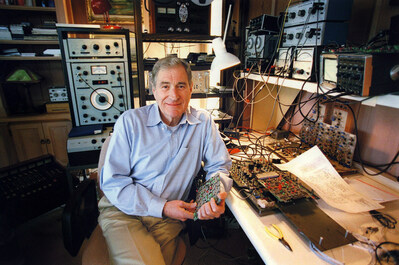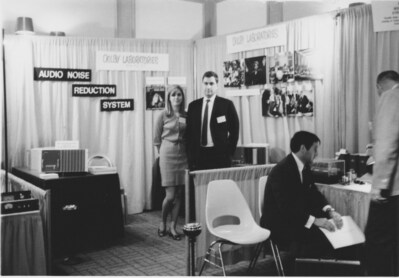Sound pioneer Ray Dolby's personal papers are donated to Stanford Libraries' Silicon Valley Archives
Dolby, known for taking the hiss out of tape recordings and developing sound technologies that revolutionized the entertainment industry, meticulously documented his curiosity and passion for sound, which started at an early age as revealed by high school papers.

Ray Dolby at his workbench in his home lab in San Francisco, 1986. Courtesy of Dagmar Dolby


Dagmar & Ray Dolby at Audio Engineering Society exhibit of A301 Audio Noise Reduction System, Los Angeles, California, c. 1968.
"The addition of Ray's papers in the Silicon Valley Archives offers scholars a rich corpus of primary source material spanning the early years of sound recording inventions and history," said Michael A. Keller, the Ida M. Green University Librarian at Stanford. "Moreover, this wonderful treasure trove of material offers a glimpse into the person behind the technology that changed the way we experience movies and recordings."
Having accumulated 50 patents, two Oscars, a Grammy and several Emmys, Dolby always sought answers to questions and solutions to dilemmas. Curiosity fueled him, and stayed with him even as he battled acute leukemia and Alzheimer's Disease, succumbing to his illnesses in 2013.
"Ray was a tinkerer in every sense of the word," said Dagmar Dolby, his widow and president of the Ray and Dagmar Dolby Family Fund. "Traveling was critically important to his discovery process. He met people from all corners of the globe, listened intently and set out to make a difference." The archive, Dolby notes, shows a bit of his quest through photography, which became another favorite pastime, as well as his writings, sketches and more formal documentation of his work.
Dagmar Dolby, who married Dolby in 1966 took an active part in the early days of Dolby Laboratories, not only as Dolby's support system, but in a variety of roles, including as a circuit board wirewoman when their small staff could not fill orders fast enough to keep up with demand. She was always at his side at exhibitions and traveled with him all over the world starting with a visit to India and an overland trip back to the west when he held a post for UNESCO as scientific advisor.
She decided to donate the archive to Stanford now as she prepares to publish a memoir about her husband and said, "It is fitting to have Ray's papers return to Stanford and remain in the Bay Area where Ray went to high school, college, and where he started his earliest career nearby at Ampex, when he became the inventor of the electronics behind the first video tape recorder."
The Ray Dolby Papers will have research value across many disciplines at Stanford and beyond and the connections between Dolby and Stanford continue to be discovered. "Dolby Labs and Stanford's Center for Computer Research in Music and Acoustics (CCRMA) have had much in common over the decades," said Chris Chafe, the Duca Family Professor of Music at Stanford and the Director of CCRMA. "Research on digital sound and spatial hearing has involved staff and students working at both, often sharing hard questions and algorithm development."
The Intersection of Art & Technology
Although he received a degree in electrical engineering at Stanford, Dolby was also a musician and a great admirer of music. His fascination with sound is said to have originated as early as childhood. Later in life he taught himself the clarinet and equipped his home office and lab with a basket of hand instruments which he often used to test for transient sounds when perfecting various technological inventions. It was this deep appreciation for music that led Dolby to use his scientific training to transform the sound of entertainment.
When Dolby Laboratories was founded, movies and television only had one channel of sound and music producers were limited in the types of audio tracks they could use. Surround sound and other Dolby-related technologies changed that and provided an immersive experience for cinema, which continues to expand opportunities for artists, directors and creative professions.
Dolby Laboratories now operates in more than 20 countries with thousands of films and innumerable products leveraging Dolby technologies, further demonstrating the scientific and artistic worlds Dolby traversed.
"The Silicon Valley Archives includes collections that document the historical interplay between technology and entertainment," said Henry Lowood, the Harold C. Hohbach Curator at Stanford Libraries who oversees the Silicon Valley Archives. "The Ray Dolby papers will provide a significant perspective on this topic as it relates to audio technology, joining collections like the Ampex collection, the Mary Beth and Richard Hess technical manual collection, and the John Chowning papers in University Archives, among others."
The Silicon Valley Archives was founded in 1985 and has become a leading repository of materials related to the history and development of Silicon Valley, documenting the region's transition from an agricultural center of farmlands and orchards to a hub of technological and scientific innovation.
"The addition of Ray's papers in the Silicon Valley Archives offers scholars a rich corpus of primary source material spanning the early years of sound recording inventions and history," said Michael A. Keller, the Ida M. Green University Librarian at Stanford. "Moreover, this wonderful treasure trove of material offers a glimpse into the person behind the technology that changed the way we experience movies and recordings."
Having accumulated 50 patents, two Oscars, a Grammy and several Emmys, Dolby always sought answers to questions and solutions to dilemmas. Curiosity fueled him, and stayed with him even as he battled acute leukemia and Alzheimer's Disease, succumbing to his illnesses in 2013.
"Ray was a tinkerer in every sense of the word," said Dagmar Dolby, his widow and president of the Ray and Dagmar Dolby Family Fund. "Traveling was critically important to his discovery process. He met people from all corners of the globe, listened intently and set out to make a difference." The archive, Dolby notes, shows a bit of his quest through photography, which became another favorite pastime, as well as his writings, sketches and more formal documentation of his work.
Dagmar Dolby, who married Dolby in 1966 took an active part in the early days of Dolby Laboratories, not only as Dolby's support system, but in a variety of roles, including as a circuit board wirewoman when their small staff could not fill orders fast enough to keep up with demand. She was always at his side at exhibitions and traveled with him all over the world starting with a visit to India and an overland trip back to the west when he held a post for UNESCO as scientific advisor.
She decided to donate the archive to Stanford now as she prepares to publish a memoir about her husband and said, "It is fitting to have Ray's papers return to Stanford and remain in the Bay Area where Ray went to high school, college, and where he started his earliest career nearby at Ampex, when he became the inventor of the electronics behind the first video tape recorder."
The Ray Dolby Papers will have research value across many disciplines at Stanford and beyond and the connections between Dolby and Stanford continue to be discovered. "Dolby Labs and Stanford's Center for Computer Research in Music and Acoustics (CCRMA) have had much in common over the decades," said Chris Chafe, the Duca Family Professor of Music at Stanford and the Director of CCRMA. "Research on digital sound and spatial hearing has involved staff and students working at both, often sharing hard questions and algorithm development."
The Intersection of Art & Technology
Although he received a degree in electrical engineering at Stanford, Dolby was also a musician and a great admirer of music. His fascination with sound is said to have originated as early as childhood. Later in life he taught himself the clarinet and equipped his home office and lab with a basket of hand instruments which he often used to test for transient sounds when perfecting various technological inventions. It was this deep appreciation for music that led Dolby to use his scientific training to transform the sound of entertainment.
When Dolby Laboratories was founded, movies and television only had one channel of sound and music producers were limited in the types of audio tracks they could use. Surround sound and other Dolby-related technologies changed that and provided an immersive experience for cinema, which continues to expand opportunities for artists, directors and creative professions.
Dolby Laboratories now operates in more than 20 countries with thousands of films and innumerable products leveraging Dolby technologies, further demonstrating the scientific and artistic worlds Dolby traversed.
"The Silicon Valley Archives includes collections that document the historical interplay between technology and entertainment," said Henry Lowood, the Harold C. Hohbach Curator at Stanford Libraries who oversees the Silicon Valley Archives. "The Ray Dolby papers will provide a significant perspective on this topic as it relates to audio technology, joining collections like the Ampex collection, the Mary Beth and Richard Hess technical manual collection, and the John Chowning papers in University Archives, among others."
The Silicon Valley Archives was founded in 1985 and has become a leading repository of materials related to the history and development of Silicon Valley, documenting the region's transition from an agricultural center of farmlands and orchards to a hub of technological and scientific innovation.
The Ray Dolby Papers are not yet available for research. Interested scholars should contact the Silicon Valley Archives to learn more.































































































